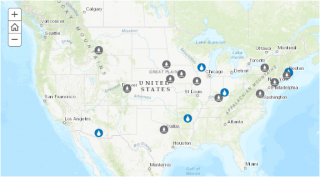
Below are resources to help states and water utilities implement the Lead and Copper Rule.
AnnouncementsOn This Page

EPA's 2021 LCRR Implementation Fact Sheet describes the 2021 Lead and Copper Rule Revisions (LCRR) requirements that public water systems must comply with starting on October 16, 2024 as outlined in the Lead and Copper Improvement (LCRI) proposal. These requirements include the initial service line inventory, notification to persons served of known or potential lead service line, Tier 1 public notification of a lead action level exceedance, and associated reporting requirements.
This fact sheet summarizes the EPA's requirements for notification to persons served of known or potential service lines containing lead required under the 2021 Lead and Copper Rule Revisions.
This document provides templates that water systems can use to develop the required notices to all persons served at the service connection with a lead, galvanized requiring replacement (GRR), or lead status unknown service lines, required under the 2021 Lead and Copper Rule Revisions.
The 2021 Lead and Copper Rule Revisions require water systems to issue a Tier 1 Public Notification (PN) when there is an exceedance of the lead action level no later than 24 hours after the systems learns of an exceedance. This document provides a template that water systems can use to develop a Tier 1 PN for a lead action level exceedance.
This fact sheet summarizes EPA’s requirements following a lead action level exceedance for timing, content, and delivery of a Tier 1 Public Notice.
EPA's Guidance for Developing and Maintaining a Service Line Inventory supports water systems with their efforts to develop initial inventories and provides states with needed information for oversight and reporting to EPA. The guidance provides essential information to help water systems comply with the 2021 Lead and Copper Rule Revisions requirement to prepare and maintain an inventory of service line materials by October 16, 2024.
EPA's Developing and Maintaining a Service Line Inventory: Small Entity Compliance Guide supports water systems, particularly small water systems, in complying with the 2021 Lead and Copper Rule Revisions (LCRR) initial inventory requirements. EPA's Small Entity Compliance Guide explains the initial inventory relate actions small community and non-transient non-community water systems are required to take under the LCRR.
EPA's Fact Sheet for Developing and Maintaining a Service Line Inventory can help water systems quickly identify the key 2021 LCRR initial inventory requirements, including inventory elements, planning, records review , investigations, public accessibility, and information for non-lead systems.
This guidance provides a comprehensive discussion of the monitoring and monitoring-related reporting requirements of the LCR. It incorporates the 2000 and 2007 Revisions to the Rule.
This memo reiterates and clarifies elements of the LCR associated with the collection of samples. It also clarifies the calculation of lead 90th percentile for compliance.
This guidance describes how PWSs and states determine compliance with optimal water quality parameters. It reflects the 2000 Revisions to the rule.
The fact sheet summarizes the public education (PE) and other public information notification requirements the revised LCR. It provides community water systems (CWSs) with information on what they need to do after a lead action level exceedance. It includes consumer notification requirements that are not dependent on a lead action level exceedance.
The PE guidance details the new PE requirements for CWSs. This includes:
The fact sheet summarizes all of the PE and consumer notification requirements for a non-transient non-community water systems (NTNCWS). It provides NTNCWS with concise information on what they need to do after a lead action level exceedance. It includes consumer notification requirements that are not dependent on a lead action level exceedance.
The guidance details the new PE requirements for NTNCWS, such as:
This document provide technical recommendations that both systems and primacy agencies can use to comply with LCR corrosion control treatment requirements and effective evaluation and designation of optimal corrosion control treatment.
This manual is intended for PWSs and states. It assists with selecting treatment strategies for controlling lead and copper in drinking water.
Appendix A supplements the Final Revised Guidance Manual for Selecting Lead and Copper Control Strategies
This guidance provides a discussion of the LCR requirements related to lead service line replacement. It reflects the 2000 Revisions to the Rule.
This interactive website allows you to explore communities across the country and learn about their programs to replace lead in drinking water systems.
This document provides a "how to" approach for EPA Regions, tribes, and states that will implement the final regulation. It contains an explanation of the rule requirements. It also contains guidance for preparing state primacy revision applications. The implementation guidance also covers monitoring requirements, violation determination, and data reporting.
The purpose of this guidance manual is to provide assistance to EPA, states, and public water systems (PWSs) for the implementation of the LCR Minor Revisions. The guidance contains information on:
This guidance provides information on monitoring waivers for PWSs that serve 3,300 or fewer people. These PWSs must have low lead and/or copper 90th percentile levels and meet plumbing material restrictions.
PWSs also have to comply with microbial and disinfection byproduct rules. Chapter Four of this manual focuses on potential LCR issues that can arise when complying with all rules.
Simultaneous Compliance Guidance Manual for Stage 2 Rules
This manual discusses the issues that PWSs face as they implement changes to comply with:
while still being required to comply with earlier rules such as:
Some of the changes may have compliance or operational consequences if not properly designed, implemented, and monitored.